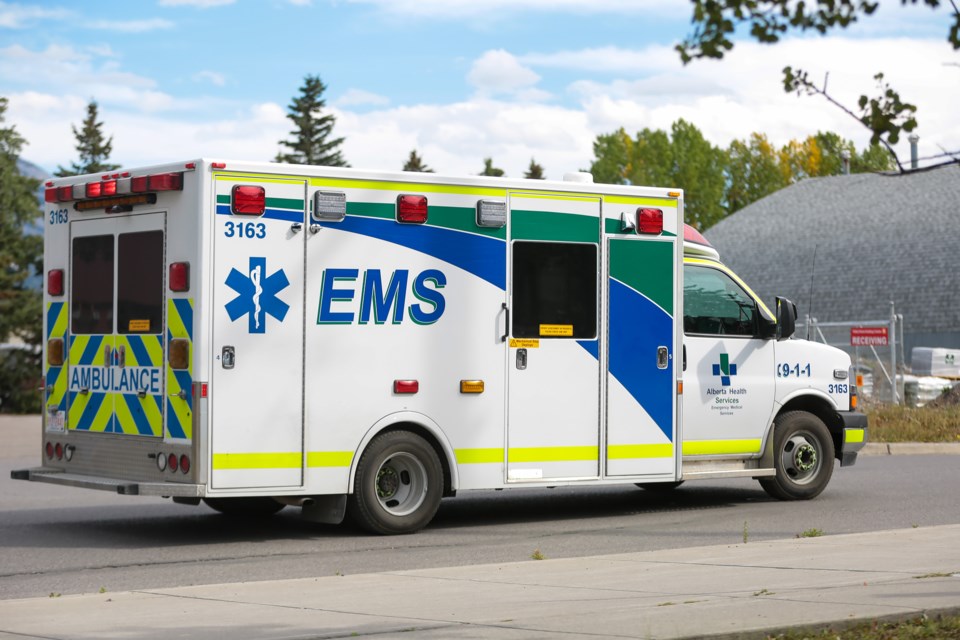BOW VALLEY – The Bow Valley was left without adequate ambulance coverage several times over the holidays.
On Dec. 27, the Bow corridor was on so-called red alert, when ambulances from Banff, Canmore and Kananaskis Country were all responding to emergencies in Calgary around the same time.
“HSAA encourages anyone experiencing a medical emergency to call 911,” was the post in response to the situation from the Health Sciences Association of Alberta (ASAA), a union of health care professionals that includes paramedics.
The group is tracking and posting data from around the province on its Facebook page. The information provided in the posts comes from HSAA members currently working in Emergency Medical Services (EMS) within Alberta.
On Jan. 2, Kananaskis EMS responded to an emergency in Cochrane and a Canmore ambulance was called away to an emergency event in Calgary. A Banff ambulance was also called to Calgary for an emergency that day, too.
On Jan. 1, a Banff ambulance in Calgary was responding to 911 calls there. A Canmore ambulance responded to an emergency in Calgary on Dec. 30 and two ambulances from Canmore responded to emergency events in Calgary the day before that.
This leaves residents who call 911 for a medical emergency potentially experiencing lengthy response times, which can be far longer than what paramedics say is considered appropriate for life-threatening emergencies.
Province-wide, EMS paramedics and other healthcare professionals are advocating for ambulances designated to serve the communities in which they are stationed to remain there instead of being called away to other locations such as Calgary, potentially for the entire day.
Alberta Health Services’ current province-wide dispatch system for EMS requires the closest ambulance to go on every call, regardless of the priority status of the patient.
For example, ambulances are dispatched to Calgary from both the station they are attached to as well as after clearing a city hospital. Local ambulances are also flexed, which means they are moving from station to station to adjust coverage.
In addition, paramedics are required to stay with a patient at city hospitals until a bed is available to treat the patient – commonly referred to as hallway waits – which can often take hours of time.
This province-wide issue was brought up at the recent annual conference of Alberta Municipalities, which resulted in resolutions calling for immediate action by the Alberta government to address the situation.
Banff Mayor Corrie DiManno said the Town of Banff is concerned about reports regarding unavailable ambulances locally, noting this is why council has asked administration for details on the situation and to bring a report to council in early 2022.
"This data will help to inform next steps as we work toward solutions with the province," she said.
In Canmore, council has asked Alberta Health Services to send representatives to discuss the alarming issue.
According to statistics from the past four years, ambulances stationed in Canmore have responded to 1,050 calls – 66.8 per cent in Canmore and the remainder elsewhere during 2018. Since then, it has steadily responded to more calls outside Canmore.
In 2019, local ambulances answered 1,131 calls with 69.1 per cent in Canmore. However, in 2020, of the 1,219 calls in Canmore 59.9 per cent were local. Up until Sept. 30 in 2021, Canmore ambulances responded to 1,237 calls with only 46 per cent being local.
“It clearly shows there’s an increase in the number of calls that ambulances stationed in Canmore are going to and a lower percentage of them are in Canmore,” said Mayor Sean Krausert in a recent council meeting.
“There are a lower number of calls that are in Canmore with an increasing number being in Calgary and other locations.”
In addition, these ambulance delays due to the current province-wide dispatching system are also putting added stress on local fire departments as they tend for patients while waiting for ambulances to arrive.
In one of the more recent events in Banff National Park, Banff Fire Department was first on the scene of a serious head-on collision on Highway 93 South, just south of Storm Mountain Lodge on Dec. 18.
Six ambulances ended up attending the scene to help deal with seven injured patients, including an eight-year-old child who was taken to the Alberta Children’s Hospital in Calgary with multiple injuries. One ambulance came from as far away as Priddis, which is about 160 kilometres from the accident site.
In Canmore, Canmore Fire-Rescue is often first on scene ahead of an ambulance.
In 2021, the average time that Canmore Fire-Rescue was on the scene ahead of an ambulance was as low as 4:19 minutes and peaking at 12:58 minutes.
“We’re trending towards 70 per cent of the time the fire department is getting to calls ahead of EMS,” said Mayor Krausert. “The overall trend is going up. The amount of time ahead of EMS is increasing.”




